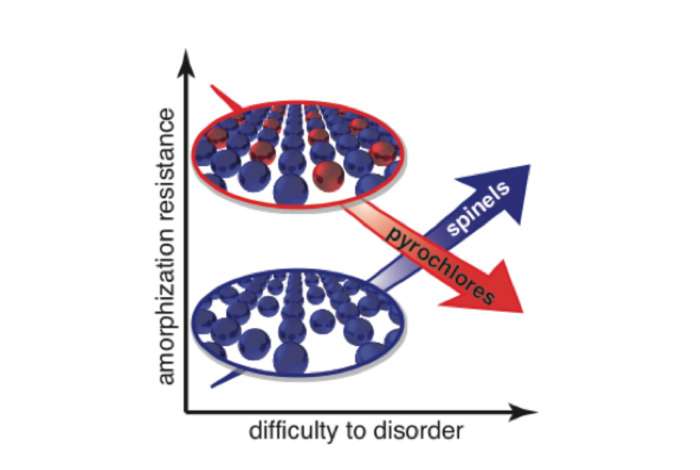Researchers uncover new origins of radiation-tolerant materials

A new report from Los Alamos National Laboratory this week in the journal Nature Communications provides new insight into what, exactly, makes some complex materials radiation tolerant.
The goal of such projects is to understand at a fundamental level just how materials respond to being irradiated, and how that response depends on fundamental properties of the material, such as its crystal structure and crystal chemistry. Focusing on oxide ceramics that have potential application for storing nuclear waste and the development of advanced nuclear fuels, the researchers discovered that fundamental differences in the structure of the material play a key role in how those materials respond to irradiation.
"There has been a lot of research on understanding what makes a complex ceramic suitable for nuclear energy applications. Our results generalize the previous understanding and provide a new path for developing radiation-tolerant materials," said Blas Uberuaga, lead author of the paper.
Relative ease in swapping cations is key to rad tolerance
Using a combination of experimental characterization and a variety of simulation techniques, the Los Alamos researchers determined that different types of complex oxides have a fundamentally different response to irradiation. Decades of work on one class of complex oxides, pyrochlore (A2B2O7), have revealed that there are correlations between the ability of the cations (A and B) to swap position and the radiation tolerance of the material. That is, for pyrochlores in which A and B can easily be swapped (such as when A=Er and B=Zr), the material is radiation tolerant.
In contrast, for pyrochlores in which this swapping is difficult (A=Er and B=Ti), the material quickly amorphizes under irradiation. This transformation from a crystalline to an amorphous structure is inherently bad for performance as it is accompanied by changes in volume and the ability of other species to diffuse out of the material.
But different oxides, different results
The Los Alamos researchers turned their attention to another class of complex oxides, spinels (AB2O4) to see if the same relationship holds. They irradiated three different chemistries of spinel and examined how the spinels responded to the irradiation damage. To their surprise, they found the exact opposite behavior as was observed in pyrochlores: in spinels, if the A and B cations are hard to swap, the material is more, not less, radiation tolerant. Using atomistic simulation methods, they attribute this difference to the fundamental manner in which the A and B atoms are arranged.
"In pyrochlores, the A and B atoms are packed very tightly and there is no room to move around. In spinels, however, they are not so tightly packed. There are holes in the structure that facilitate rearrangement of the atoms. This is the key difference between spinels and pyrochlores, a difference we believe extends to other classes of complex oxides," said Uberuaga.
The new insight from this combined experimental and modeling effort generalizes the understanding that had been developed from the study of pyrochlores and provides new opportunities for identifying radiation tolerant oxides for nuclear applications. This work was supported by the US Department of Energy Office of Science.
More information: Blas Pedro Uberuaga et al. Opposite correlations between cation disordering and amorphization resistance in spinels versus pyrochlores, Nature Communications (2015). DOI: 10.1038/ncomms9750
Journal information: Nature Communications
Provided by Los Alamos National Laboratory



















